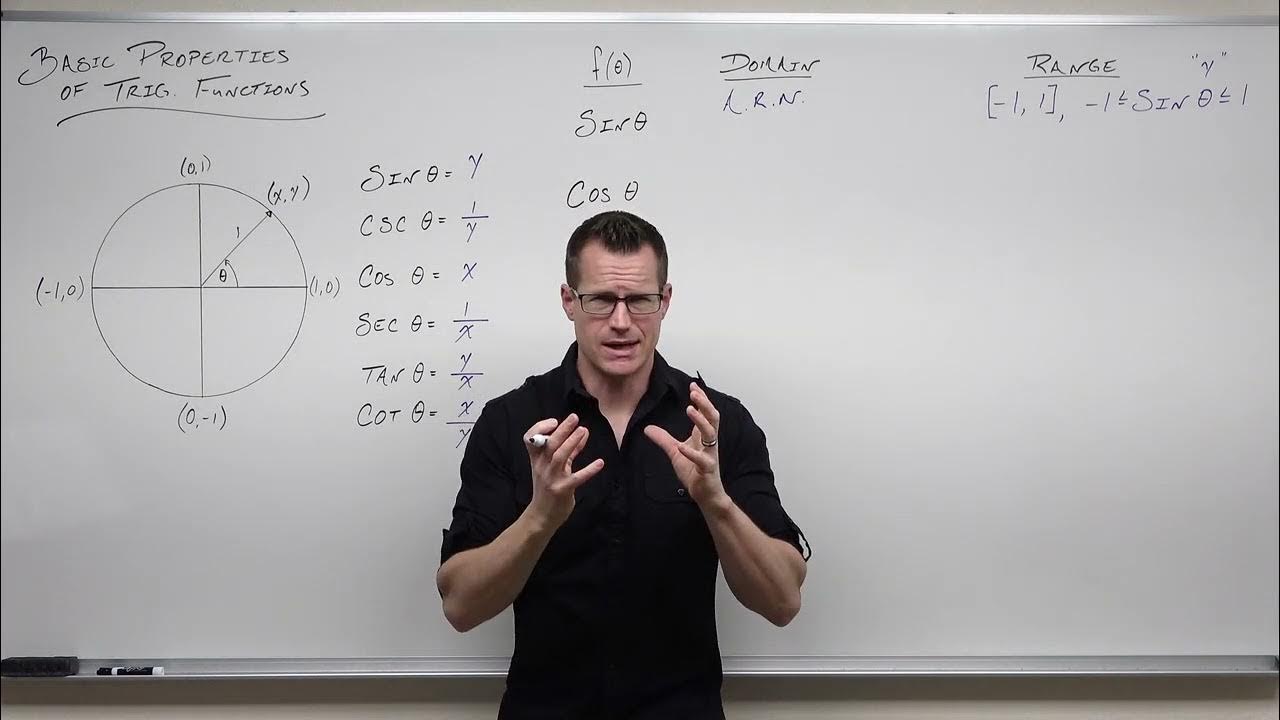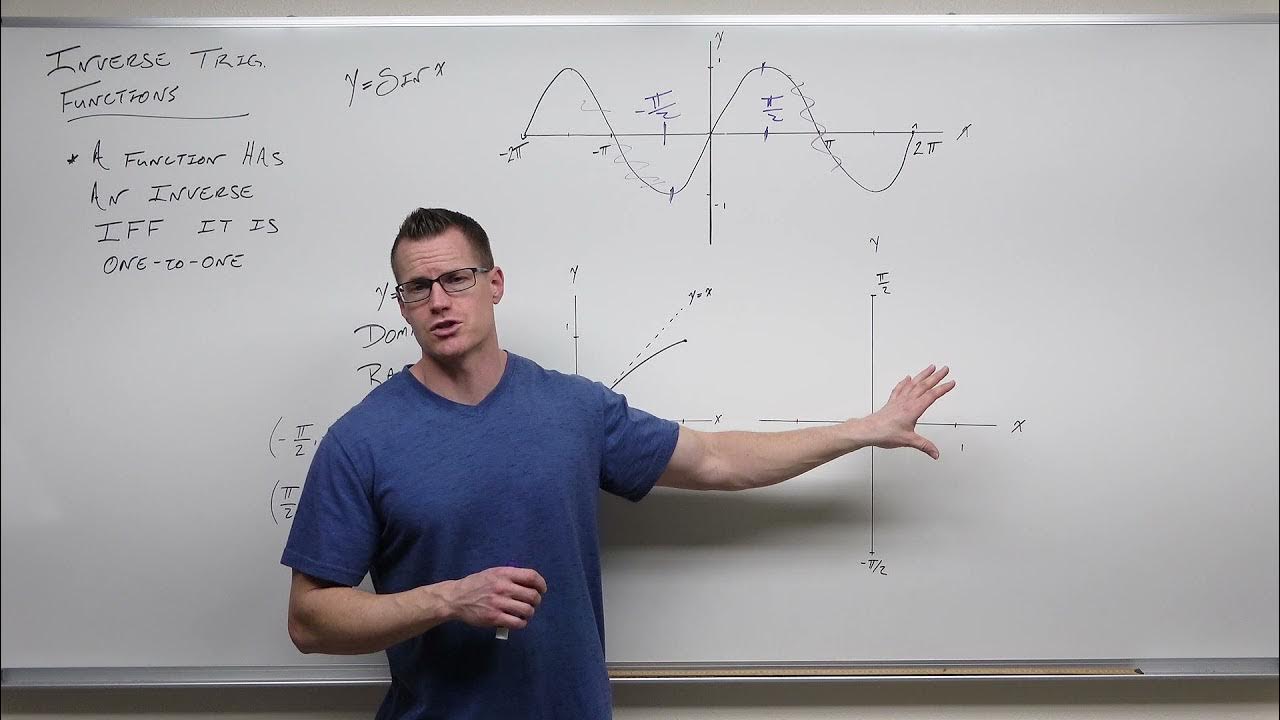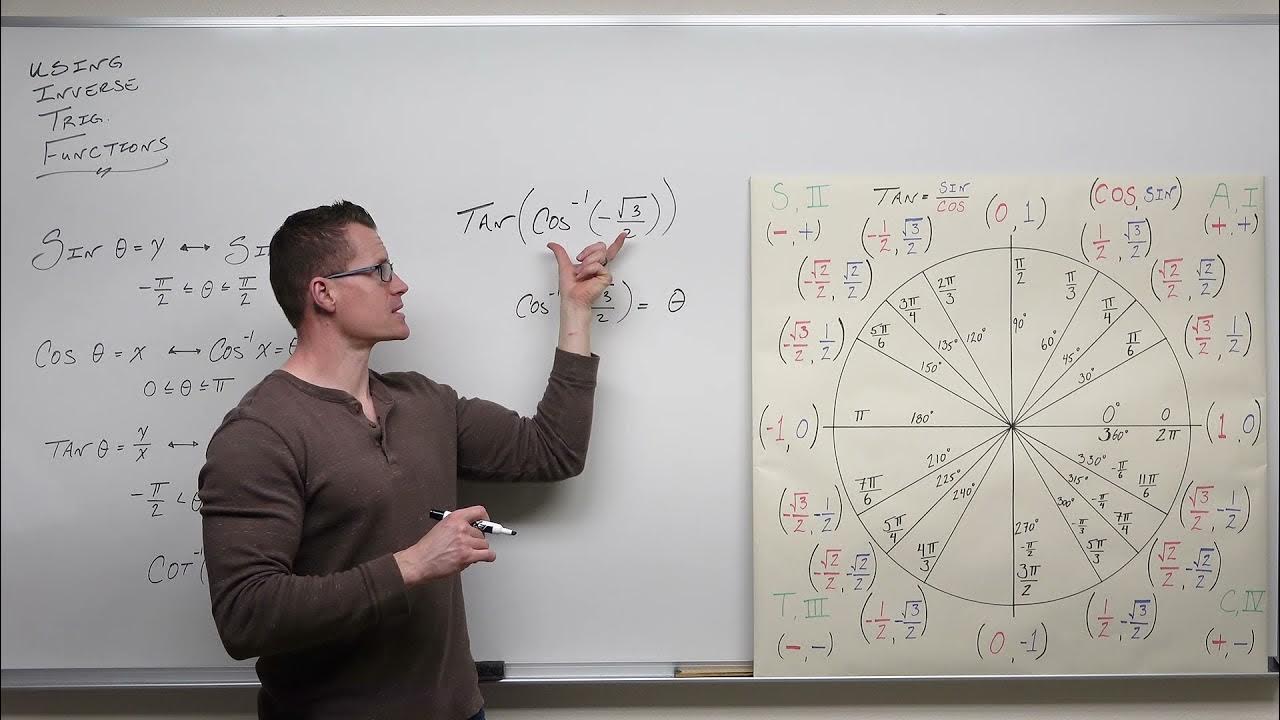How to Use Inverse Trigonometric Functions (Precalculus - Trigonometry 18)
TLDRThis video script delves into the intricate world of inverse trigonometric functions, specifically focusing on the sine, cosine, and tangent functions, along with their inverses. The importance of understanding the domains of these inverse functions is emphasized, as it dictates the intervals on which they are defined and can be applied. The script clarifies that while the input for trigonometric functions is an angle resulting in a coordinate or ratio on the unit circle, inverse functions reverse this, taking a coordinate or ratio as input and outputting the corresponding angle. The concept of function composition with inverses is explored, highlighting that composition results in cancellation, provided the domain of the inner function is respected. The script also addresses the implications of exceeding the domain and strategies to correct this, such as using the periodic nature of trigonometric functions or finding equivalent angles. The summary underscores the necessity of adhering to the domain for inverse functions to be valid, and it provides a foundation for solving equations involving inverse trigonometric functions.
Takeaways
- 📐 The domains for inverse trigonometric functions are crucial: sine and tangent inverses are defined for x between -π/2 and π/2, while cosine inverse is defined for x between 0 and π.
- 🔄 When composing trigonometric functions with their inverses, the output will always be the original input (x), given that the domain of the inner function is respected.
- 🔩 The input for direct trigonometric functions is an angle, while the output is a coordinate or ratio of coordinates on the unit circle. For inverse trig functions, it's the opposite.
- 🧭 The range of the original trigonometric functions becomes the domain of their inverses. For example, the domain of sine inverse is all real numbers between -1 and 1.
- ⚖️ The concept of even and odd functions can help when dealing with inverses outside their original restricted domain, such as changing the sign for even functions like cosine.
- 🔗 The domain of the inner function in a composition must align with the restricted domain for the inverse function to be valid.
- ✋ If the input to an inverse trigonometric function is not within the appropriate domain, the function is undefined and cannot be simplified.
- 🔙 When finding the inverse of a function, you are essentially looking for an angle that corresponds to a given coordinate or ratio of coordinates on the unit circle.
- 🔢 For non-standard inputs to inverse trig functions (like values outside the range of -1 to 1), it's necessary to use the unit circle and properties of trig functions to find equivalent angles within the defined domain.
- ⛓ The restriction of the domain for inverse trig functions ensures a one-to-one correspondence, which is necessary for the inverse function to be valid.
- 🔍 To solve equations involving inverse trig functions, one can use the property that composing a function with its inverse results in the cancellation of the function, leaving the original argument.
Q & A
What are the domains for the inverse trigonometric functions sine, cosine, and tangent?
-The domains for the inverse trigonometric functions are as follows: for sine and tangent, it is between negative pi/2 and pi/2, while for cosine, it is between 0 and pi.
How does the range of the trigonometric functions relate to the domain of their inverses?
-The range of the trigonometric functions becomes the domain for their respective inverse functions. For instance, the range for sine, cosine, and tangent is between -1 and 1, which is also the domain for their inverses.
What is the main concept behind the composition of a function with its inverse?
-The main concept is that composing a function with its inverse results in the cancellation of the function and its inverse, ultimately yielding the variable x as the result.
Why is it important to restrict the domains of sine, cosine, and tangent for their inverses to apply?
-Restricting the domains ensures that the inverse functions are well-defined and one-to-one, which is necessary for the inverses to be valid and for the composition with the inverse to cancel out properly.
How does the input and output of a trigonometric function compare to that of its inverse?
-In a trigonometric function, the input is an angle and the output is a coordinate (or ratio of coordinates) on the unit circle. In contrast, for an inverse trigonometric function, the input is a coordinate (or ratio of coordinates) and the output is the angle that corresponds to those coordinates.
What happens when the domain of the inside function in a composition is not met?
-If the domain of the inside function is not met, the composition of the function with its inverse does not cancel out, and the operation is not valid or well-defined.
How can you find the angle equivalent for a given sine inverse value that is outside the restricted domain?
-You can find an angle equivalent by using the symmetric nature of the unit circle or by considering the periodicity of the sine function to find an angle within the restricted domain that has the same y-coordinate.
Why is it not possible to find a sine inverse for a value outside the range of -1 to 1?
-The sine function, by definition, has a range of -1 to 1. Therefore, there is no angle on the unit circle that would correspond to a sine value outside this range, making the sine inverse for such a value undefined.
What is the significance of the domain when solving equations involving inverse trigonometric functions?
-The domain is significant because it determines whether the inverse trigonometric function is defined and if the composition with the function will cancel out as expected. If the domain is not met, the equation cannot be solved using the inverse function as intended.
How does the periodicity of trigonometric functions allow for flexibility when working with inverses?
-The periodicity of trigonometric functions means that they repeat their values in regular intervals. This allows for flexibility in finding equivalent angles outside the restricted domain by adjusting for the period of the function.
What is the domain of the inverse sine function, and why is it important to consider when solving compositions?
-The domain of the inverse sine function is all real numbers between -1 and 1, inclusive. It is important to consider this domain when solving compositions to ensure that the resulting value falls within the range of the sine function, allowing for the proper cancellation of the function and its inverse.
Outlines
😀 Understanding Inverse Trigonometric Functions
The video begins with an introduction to inverse trigonometric functions, emphasizing the importance of understanding their domains. The domains for arcsine, arccosine, and arctangent are discussed, and it is explained that the range of the original trigonometric functions becomes the domain for their inverses. The concept of the unit circle and how it relates to the inputs and outputs of trigonometric and inverse functions is also introduced.
🔢 Domain and Range Restriction for Inverse Functions
This paragraph delves deeper into the restrictions of the domains and ranges of inverse trigonometric functions. It explains that the input for an inverse trigonometric function must be within the range of the original function for it to have an inverse. The video also clarifies that the output of an inverse function is an angle, and it must align with the original function's domain for a one-to-one correspondence.
🔁 Function Composition and Cancellation
The concept of composing a function with its inverse and the resulting cancellation is explored. It is shown that for the composition to be valid, the domain of the inner function must be within the restricted domain for the inverse function to exist. Several examples are given to illustrate when compositions work and when they do not, based on the domain of the inner function.
🤔 Dealing with Non-Standard Inputs for Inverse Functions
The video addresses how to handle inputs that fall outside the standard domain for inverse trigonometric functions. Techniques such as utilizing the periodic nature of trigonometric functions or finding equivalent angles within the restricted domain are discussed. The importance of ensuring a one-to-one correspondence between inputs and outputs is highlighted.
📐 Using the Unit Circle for Inverse Trigonometric Functions
This section focuses on the practical application of the unit circle when dealing with inverse trigonometric functions. It demonstrates how to find angles corresponding to given y or x coordinates (for sine and cosine, respectively) and ratios (for tangent) by aligning them with the correct portion of the unit circle that falls within the defined domain.
🧮 Calculations and Rationalization for Inverse Tangent
The video provides methods for calculating and rationalizing ratios for the inverse tangent function. It explains how to find angles that correspond to specific y/x ratios and emphasizes the need to be within the first and fourth quadrants for tangent and its inverse due to its periodicity and the nature of the unit circle.
🚫 Handling Undefined Compositions of Inverse Functions
The final paragraph discusses the limitations of composing functions with their inverses when the input does not fall within the required domain. It clarifies that certain compositions are undefined because they do not meet the necessary conditions, such as an input that does not correspond to any angle on the restricted domain of the unit circle.
Mindmap
Keywords
💡Inverse Trigonometric Functions
💡Domain
💡Range
💡Unit Circle
💡Trigonometric Ratios
💡Composition of Functions
💡One-to-One Function
💡Vertical Asymptotes
💡Angles and Coordinates
💡Non-Function
💡Radian Measure
Highlights
The importance of understanding the domains of inverse trigonometric functions like sine, cosine, and tangent, and their respective inverses.
The domain restrictions for sine and tangent are between negative pi over 2 and pi over 2, while cosine has a domain of 0 to pi inclusive.
The range of the original trigonometric functions becomes the domain for their inverses, meaning sine inverse's x must be between -1 and 1, cosine inverse also ranges from -1 to 1, and tangent inverse can take any real number.
The role of inverse functions in trigonometry is to cancel out the original function when composed together, leading to the solution of trigonometric equations.
The concept of the input for trigonometric functions being an angle and the output being a coordinate or ratio of coordinates on the unit circle is reversed for inverse functions.
The demonstration of how sine inverse of zero asks for an angle with a y-coordinate of zero within the restricted domain, resulting in an angle of zero radians.
The process of finding the angle for cosine inverse of one, which involves locating the angle that gives an x-coordinate of 1 on the unit circle within the domain of 0 to pi, leading to an answer of zero radians.
The method of determining the angle for tangent inverse of negative one by finding the angle that makes the y over x ratio equal to negative one within the restricted domain of negative pi over 2 to pi over 2, resulting in an angle of negative pi over 4.
The explanation of why the domain for sine and cosine inverse functions is restricted to specific intervals on the unit circle, emphasizing the necessity for a one-to-one correspondence to avoid multiple outputs for a single input.
The example of how to find the angle for cosine inverse of negative 1 by ensuring the x-coordinate is within the domain of 0 to pi, leading to the angle of pi.
The process of determining the angle for sine inverse of a value outside the domain by finding an equivalent angle within the restricted domain that has the same y-coordinate.
The demonstration of how to find the angle for tangent inverse of a value outside the domain by finding an equivalent angle within the restricted domain that has the same y/x ratio.
The explanation of how the composition of a function and its inverse results in the cancellation of the function, providing a powerful tool for solving trigonometric equations.
The illustration of how to adjust angles outside the domain of an inverse function by finding angles within the domain that have the same x-coordinate or y-coordinate, ensuring the validity of inverse function compositions.
The clarification that if the input for an inverse trigonometric function falls outside the defined domain, the function is not defined and cannot be computed.
Transcripts
Browse More Related Video

How to Solve Basic Inverse Trigonometric Functions (Precalculus - Trigonometry 20)

Basic Properties of Trigonometric Functions (Precalculus - Trigonometry 8)

Introduction to Inverse Trigonometric Functions (Precalculus - Trigonometry 17)

An Indepth Look at Using Inverse Trig Functions (Precalculus - Trigonometry 21)

Inverse Trigonometric Functions

Calculus 2 Lecture 6.5: Calculus of Inverse Trigonometric Functions
5.0 / 5 (0 votes)
Thanks for rating: